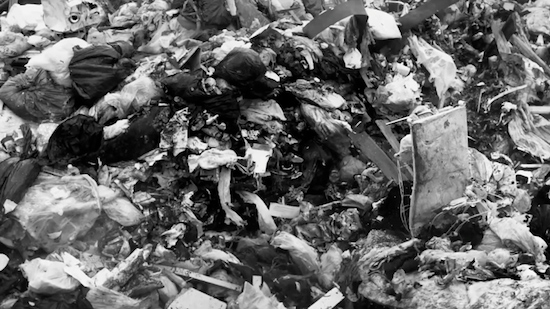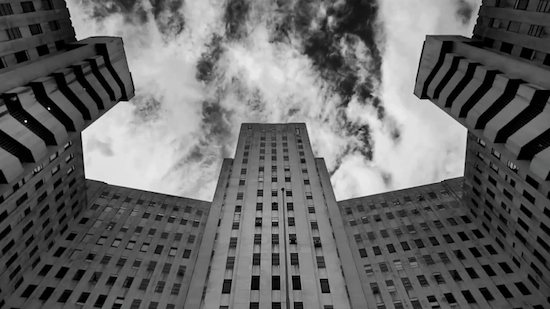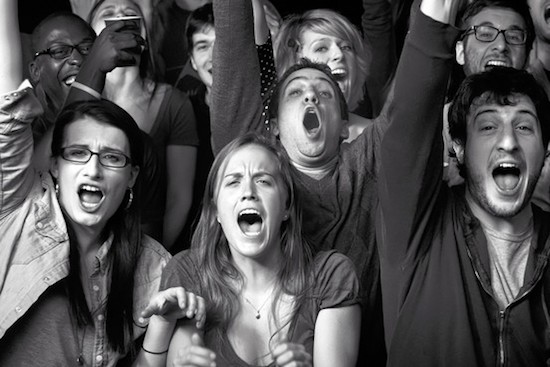 Godfrey Reggio
Godfrey Reggio
It is so amazing to come across and be exposed to an artist who is not only a true original, but one who seems to be operating from a truly higher conscious. The director Godfrey Reggio certainly qualifies as one of those rare artists who seem to aim high, as in, the collective third eye, or, the global consciousness. Although he insists that art should have no purpose, his powerful, devastating and poetically gorgeous Qatsi trilogy of films, which he is most well-known for, and which includes KOYAANISQATSI, POWAQQATSI, and NAQOYQATSI, beg to differ. Scored by Phillip Glass and filling the screen with image after image of various stages of global community, searing beauty, eco-devastation, commerce and industry- assaulting us with the most vivid, the most poignant global imagery.

His new film, VISITORS, is a complete departure from this style: We are greeted, as soon as we sit down, with still, slow faces of people, (and the wisest gorilla you have ever laid eyes upon), and we move on to close-ups of hands “playing” with invisible computer and digital devices, large groups walking, watching something (sports? porn?) and reacting in lush slo-mo, in cuts that last several minutes at a time. Oh, and did we mention it’s all shot in back-and-white?
The film is beyond wonderful, and you leave the theatre feeling centered and clear, your senses bright, your body lightened. That is how powerful an experience the film is, and, defying all current film-making convention, has under 80 cuts total.
I had both the pleasure and great honor to sit down with Mr. Reggio and his whip-smart producer Jon Kane, and we spoke about his early day as a monk with the Christian Brothers, the future of our society, reaction to Visitors, and working with his crew on Visitors.
I am so fascinated by your early journey. Before you became a filmmaker, you were a monk for many years. Can you tell us a bit about this?
I was actually a Christian Brother. Christian Brothers don’t live in monasteries, they live in community. I was like a male nun! If you look at in military terms- we were the lowest on the totem pole, we were the foot soldiers, but we did the real fighting. We weren’t like the bishops, you know, the generals, or the super generals, like the Pope! The Jesuits, who are like the Colonels, or the Lieutenants…We were a very humble order, but a very important order, for me. It was the first order of monks who were not priests. As you know, the further you get away from the founder’s spirit, and this order was founded in 1681, in that measure, you lose the spirit of the founder, and it becomes vestigial, and bureaucratized. When you have monks that are priests, and monks that are not priests, than the monks who are not priests become subservient to the ones who are- that should never be. Our mission was to teach them (the poor) to live in community in a religious way. So, when I joined the brothers, very few brothers taught the poor, because of the rationale, “How are we going to pay for ourselves?” So, being young and zealous brother, my Che Guevara was Pope John XXIII, brilliant guy, someone that didn’t even want to be the Pope, which impressed me even more! He said, “Accept nothing, and question everything, even the structure of the Church.” This was like marching orders to my young and zealous energy. Of course, I then had final vows at that time, I was a “monk for life,” and the Order asked me to leave! So it was a shock for me. It’s like getting out of prison, but at least in prison, they give you a suit, a little pocket money to get out! And there- I got nothin’! (laughs) But if I may say this, ‘I’m not a brother, a brother is me. ‘ All my proclivities are owned in that tradition.
(Producer Jon Kane walks into the room and sits down.) How did you two meet?
Jon Kane: We met originally, before Naqoyqatsi. Godfrey was trying to raise money for the film. (“Forever!” Godfrey smiles.) There was an article written in the NY Times by a friend of mine, Ty Burr, and I was a successful director of TV commercials at the time, so he asked me for a quote on the influence of Koyaanisqatsi on me, and on commercial filmmaking, generally. So, I gave him a quote, Godfrey read it, Steven Soderberg read it, and we all kind of came together, and Godfrey asked me to join him on the journey to make Naqoyqatsi.. So, I left my profession, for two years, and joined his monastery (laughs).
GR: Jon is beyond capable, and really brilliant at technology. They are other people who may be more brilliant or capable technologically, but it’s his sensibility I responded to. I feel that he’s a misplaced person in the commercial world, that his real love is art, is expression, making, doing… The only requirement I had was….well….he had an extremely commercial company, and he had to give it up come and work with me. He had a wife, kids, and I paid him a pittance!

Tell us about your new film VISITORS.
GR: 74 images in 87 minutes and 33 seconds! (The form followed the idea of) ….the moving still. What that meant depended upon what the photography would reveal. The portraits in the very beginning of the film- there were six portraits, beginning with the woman with very intense eyes, and ending with this gorgeous old black woman… (He gestures to the very long conference table the three of us are sitting at one end of) Take this table (he gestures all he way down to the other end) if the portrait person is sitting in that chair, and the camera is here (he gestures near us)-now, the simple way to do it would be to use a zoom lens, but it doesn’t have the same effect. So, the camera is on a dolly track, and the Assistant Camera person has to rack focus as it’s tracking, so, it’s very demanding. I asked for the shot to be slow. The DP, Graham, flipped out! (He laughs.) He said, “Godfrey, you can’t even get a machine to do that! You want us to something that’s not human!” And we had a beautiful grip there, Danny, and he says….
JK: It was the slowest dolly move in history!
GR: One person could never do it. But this Danny, he had his assistant held the wheels, and just went imperceptibly slow…So that already, in the photography, indicated that the moving still was what we were trying to get at…
JK: Also, one of his instructions to me was that every shot in the film had to be its own movie- with a beginning, middle and end. We don’t have coverage in this movie. There are no edits in the traditional sense, where you start wide, and cut to a detail. No shot relies on the other shot for its power, or its meaning. Each shot is its own, contained thing.

How did this process work with the gorilla?
JK: We shot her over six days, for a variety of reasons. To try and get this gorilla at the Bronx Zoo, shooting with a 3000 mm lens, through glass, (the gorilla was in its natural environment) and we knew we wanted to capture the full face of this gorilla, and make it live with these portraits. The idea at first was just to get the gorilla looking in the camera, which was hard enough! Finally, we got a long take of the gorilla, where a variety of things happened- the blinks, the head moves. So, we did get the gorilla looking in the camera. That said, those two shoots took two animators six months to realize them in the form they are in now, for a variety of reasons.
GR: Let me add something. Had we seen the gorilla, say if she was in Uganda, or the Bronx Zoo spent thirty million to make it look like Africa, than we would be looking at a “gorilla.” But if you take the background out of the gorilla, and put in the “black”-ground, then the gorilla is looking at you. So, when Jon said it to them six months, think of the hairs of the gorilla, you can’t just cut an oval out!
JK: The color correction, the timing of the blinks, the breathing of the body…
GR: Everything….It’s the real gorilla, of course, but we had to take her out of the background. This beautiful animal is looking at another animal- you and me.

What has the reaction to the film been so far?
GR: Well, one, I’m surprised that we have such a passionate and extremely (hard-working) distributor. There was a much larger company that wanted to bid on it and get it, but we would have been like a salami in their shop. But this one is a new one, (Cinedigm) Susan Margolin, who is the co-President, and Emily Rothschild, who just had a baby on my daughter’s birthday- and Laura and Jeff, I mean, these people are like gold. And they don’t have ten other films to deal with. They have a lot of other stuff going on, but it’s in another dimension., They’ve really gone to the wall. I’ve had so many pre-screenings of films for press. I can’t organize that! But we had 25 screenings, coast-to-coast. And with Steven (Soderberg) coming on board, everybody knows that dude! He calls someone, and they pay attention. He truly lives the film, and his commitment is to do everything possible to make sure it gets a shot- being “in the ring, ” so it can be seen. So, that’s blowing my mind, What the reaction is, it’s hard to say…
JK: We’ve had hugely positive response, and reviews… When we screened it a Toronto Film Festival, people stayed for the entire thing. Steven said, “More people walked out of Magic Mike than this one!”
Godfrey, how do you really feel about technology?
GR: It depends on which personality you’re talking to! No, but I have a clear point of view. On the one hand, I think it’s one of the most misunderstood subjects on the planet. Two, I think we face a danger that is unspeakable, unsayable, even- it’s the vivid unknown. All we know about technology is from the people that make it, and all they want to do is sell it. So, we have no real point of view about it: Technology is not something we use, it’s something we live- it’s ubiquitous as the air we breathe in the natural environment, and in fact, it has replaced the natural environment as our host of life. It is now the environment that we live in- the great acceleration, the effect of human on the world we live in. It’s all human-made, although humans aren’t driving it anymore: We think we’re in charge, but we’ve created a Frankenstein- not Hollywood’s version, but Mary Shelly’s version- something that has a life of its own, that’s autonomous. Its determinance has us along for the ride. So, we’re like strapped in, and we’re on for the ride. I guess I’m saying that it’s not the effect of technology on the way we live, it’s that technology IS what we live.

Leave a Reply
You must be logged in to post a comment.